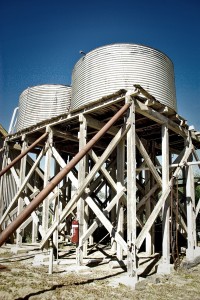Where can Asbestos be Found? Potential Sources of Asbestos

Asbestos Hazard Warning Sign
Do you have any idea where asbestos is lurking? Though regulations have become quite strict, there are still some residential and commercial sources of asbestos.
Asbestos products have gradually been disappearing but they were widely used before the introduction of bans on the use of this material and it’s still possible to find asbestos in older constructions.
Identifying and getting rid of asbestos is essential because of the numerous health risks associated to it. Here are some of the most common sources of asbestos that you could come across.
Asbestos Cement

water tank
Asbestos cement roofs and flues were common in the past. Asbestos cement roofs can be commonly found on farms and commercial properties.
Sometimes, asbestos can also be discovered in the roofs of sheds or garages. Asbestos cement flues were common in boiler systems, air conditioning and ventilation. These were typical for both commercial and residential developments.
Asbestos cement was sometimes used in the construction of water tanks, as well. Properties constructed prior to the 1980s could potentially have a water tank made of this material.
Sealants

furnace
Until the 1980s, asbestos was frequently used as a sealant around windows and doors. Its insulating properties made the material a really common pick in both residential and commercial buildings.
Asbestos is also heat-resistant, which is why the material could be found as a sealant in old furnaces. Cleaning older furnaces could potentially be a dangerous activity because it may release the asbestos particles in the air. Figuring out whether the material was used for insulation prior to getting started with cleaning will be essential.
Wallpaper
Yes, asbestos could be found in something as innocent as old wallpaper.

wallpaper
Many vinyl papers made prior to the 1980s contain asbestos. Removing those and replacing them with something a bit more innovative could be a downright dangerous task. Intact wallpaper isn’t dangerous but trying to tear it from the walls will release the asbestos fibers in the air.
If you’re looking at an older house that’s in need of wallpaper removal, you should first talk to a professional about it. Experts in the field will test the wallpaper and the adhesive for asbestos, after which they’ll recommend the best removal procedure.
Textured Coatings

textured coating
In the past, textured coatings were used as a decorative finish. They were popular for use on the walls and the ceilings of buildings.
Depending on the particular decorative effect that was sought, such textured coatings could have peaks or different patterns. The original color of the material is white. It can easily be painted over.
If undisturbed, textured coatings containing asbestos are not dangerous. Still, it’s essential to get those identified and assess the risk. If you plan to carry out a renovation project in the future that involves tearing down the coating, you’ll need professional assistance.
Floor Covers
Vinyl sheets and rubber floor covers often contained asbestos fibers in the past. These

textured tiles
materials were “tight” and heavy because of the presence of asbestos fibers. Even the adhesive that was used for such floor covers contained some amount of asbestos.
It’s a general assumption that floor covers and tiles installed prior to the 1980s contain some amount of asbestos.
The amount of asbestos in flooring is generally small and older floors can be easily covered with new materials. If the old flooring is to be removed, however, the danger will have to be evaluated in advance.
How to Check for Asbestos and Identify It
A visual inspection of your home, office or other commercial property is the only one you should be undertaking. Don’t disturb the material that could potentially be a source of asbestos. Inhaling the fibers will increase the risk of experiencing asbestos-related health problems, so be careful about it.
Asbestos is a fibrous material and any old insulation fibers could potentially contain it. Requesting the assistance of a certified professional is the best idea in such situations. The professional will take a small sample from the questionable material and lab exams will be performed to determine whether there is asbestos.
Depending on the location of the material and its condition, you’ll have to determine whether to remove it or leave it undisturbed. Asbestos products in good condition will not release dangerous fibers. If any damage has been incurred, however, safe removal will be the best strategy.
Any older building comes with the risk of asbestos being present in the construction materials. Since the health risks associated with asbestos are serious, it’s important to identify it and assess the material’s condition early enough. Asbestos-containing materials may be isolated, repaired or removed. Whichever option you choose, it’s crucial to pick a certified professional for the execution of the task.
 For instance, dust on Cobwebs and wine kegs and in old attics!.
For instance, dust on Cobwebs and wine kegs and in old attics!.





















